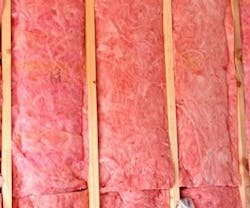Insulation and the Technology Behind It
Buildings have been targeted with ARRA (The American Recovery and Reinvestment Act of 2009) funding as the most recognized in providing the greatest opportunities in energy and greenhouse-gas reductions. A Cost Curve for Greenhouse Gas Reduction, a study by McKinsey Quarterly, estimated in 2007 that demand-reduction measures with no net cost, such as insulation, could reduce – almost by half – the projected growth in global electricity demand.
Insulation matters as a key building-system component, but it’s often overlooked as a first-choice, low-cost factor in a design to optimize energy efficiency. As with many building product sectors, new technologies are continuously developing, and insulation is no exception. In addition to well-established, proven products like fiber glass and rock and slag wool, the industry has experienced the evolution of various types of rigid board insulations, cellulose, and, more recently, foam insulations, including some that claim to be bio-based materials. Insulation products also include recycled cotton and sheep’s wool insulation. The recycled content of insulation is also of interest as it relates to LEED points. The North American Insulation Manufacturers Association recently reported that its members’ plants diverted almost 33 billion pounds of recycled materials from the waste stream with the use of glass cullet during 2006 and 2007. Some fiber glass manufacturers also offer unbonded (no binder) blow in fiber glass, while several members offer alternative binders for batt insulation.
Research has spawned the introduction of new insulation technologies, such as nano materials. Georgia Tech is investigating the development of composite materials from chicken feathers for application in buildings, including acoustic ceiling tiles, moisture-resistant drywall, and insulation. One type of green insulation that you won’t find in the United States yet is called “industrial hemp,” which is a type of “low-narcotic hemp.”
New technologies and insulation are certainly worth investigation, but authors J. David Odom, Richard Scott, and George H. DuBose, in their NCARB paper, The Hidden Risks of Green Buildings: Avoiding Moisture & Mold Problems, tell us that the use of many new building products often has the unintended consequence of performing in unexpected ways – sometimes encouraging significant moisture accumulation and mold growth by masking sources of sustaining moisture. This may require a more rigorous evaluation of these materials than is required with traditional products.
Stewart Brand’s caution in How Buildings Learn: What Happens After They’re Built (1994) echoes what forensic building consultants and building scientists have seen for decades – anything that departs from the “tried-and-true method” often fails.
Beyond insulation types, it’s also critical to understand other technologies, such as ICFs (insulating concrete forms), insulated metal panels, concrete structural insulated panel wall systems that are constructed with foam and concrete, SIPs (structural insulated panels) that include foam, rigid board, and fiber glass insulations; 2x6 advanced framing; and super-insulated system approaches to envelope design. Fiber glass high-performance batts are higher density and have higher insulating ability than standard fiber glass batts, ideal for super-insulated sidewalls where insulation levels of R-21 are recommended. Thermal performance isn’t the only benefit in specifying insulation products like fiber glass and rock and slag wool; they also provide superior fire protection and contribute to STC acoustic noise control in wall cavities, ceilings, floors, and HVAC duct systems. Fire safety in insulation materials varies and should be thoroughly researched. See Mark McLees’ article, “Going Green” May Make You “See Red,” in the June 2008 edition of Firehouse magazine.
Determining the right insulation materials for maximum building envelope energy efficiency requires whole building and integrated design strategies. The architectural design team and MEPs must collaborate through scenario planning by utilizing various modeling tools. Several tools worth noting:
- Autodesk® Green Building Studio®, a Web-based energy-analysis service that architects and designers can use to evaluate how building components impact energy consumption and improve a project’s economic and environmental performance early in the design process.
- BeOp, which calculates optimal building designs along the path to net zero energy.
- The U.S. Energy Efficiency and Renewable Energy (EERE) department’s website, which lists energy-modeling programs.
- 3E Plus Version 4, which calculates the economic, energy, and environmental savings from proper levels of industrial insulation.
- CSI’s GreenFormat, which offers environmental reporting for insulation that can be reviewed by searching www.greenformat.com. Also, under “Resources” on www.naima.org, click on “Literature Library” to find additional environmental information.
- ENERGY STAR’s Air Seal and Insulate program.
Paul R Bertram Jr. is the director of environment and sustainability at the Alexandria, VA-based North American Insulation Manufacturers Association.
